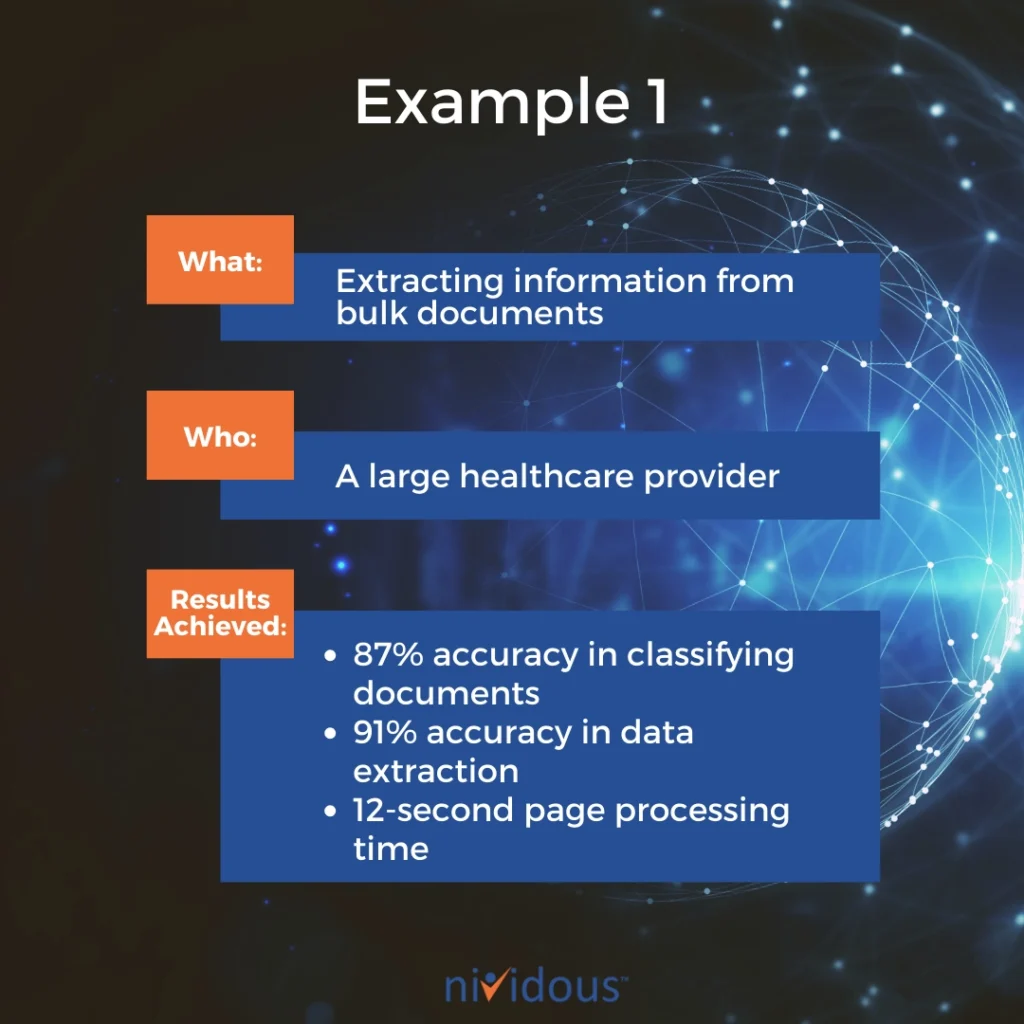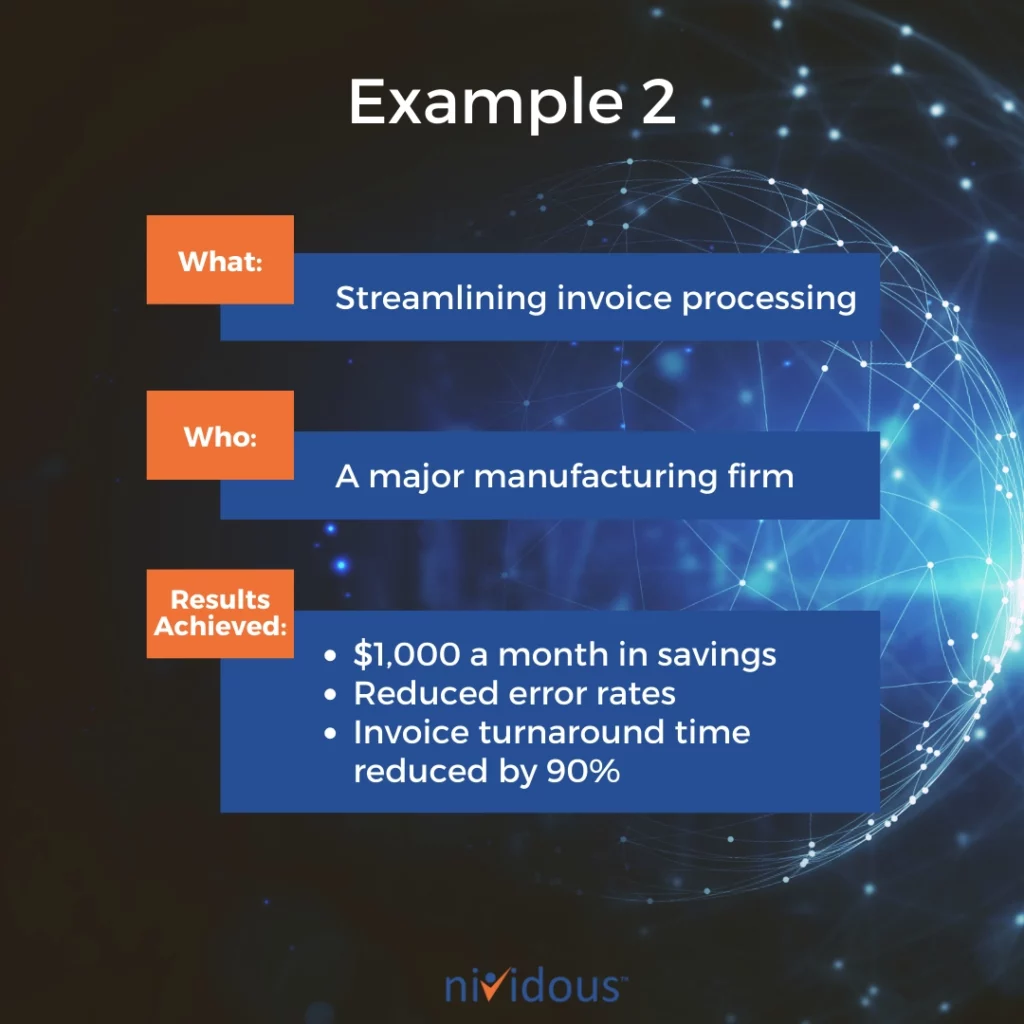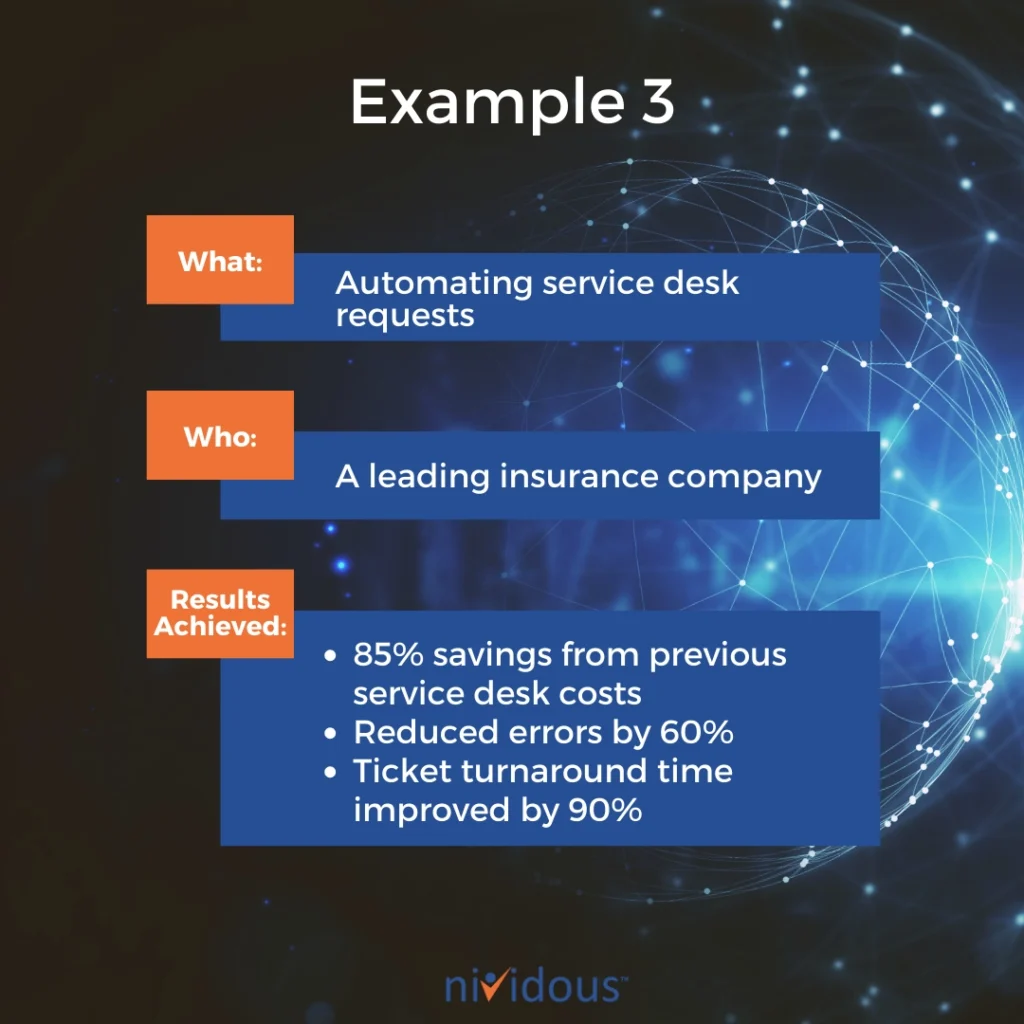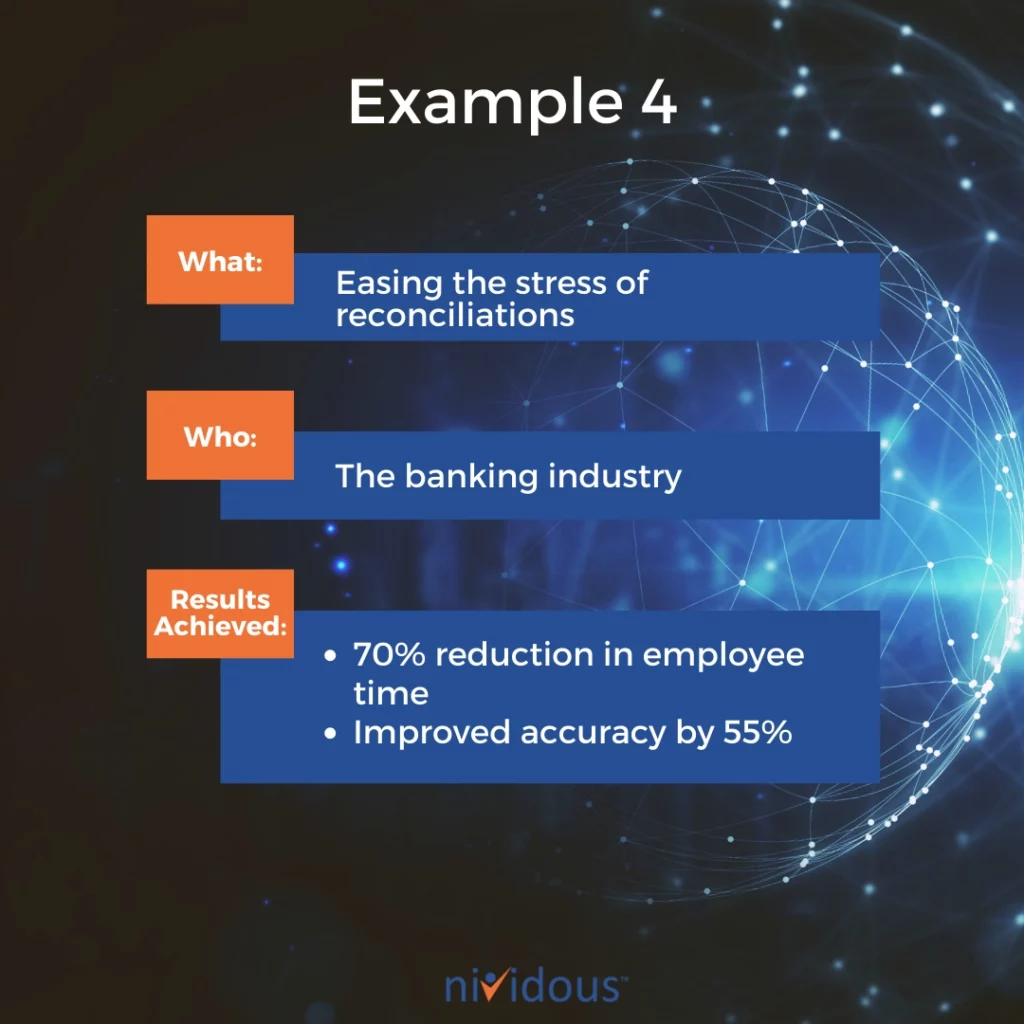What’s better for your business than automating your tedious processes with bots and macros?
The answer: Automating your business processes with intelligent bots that use AI to make educated decisions beyond the capabilities of regular bots and macros.
Intelligent automation can not only save your company time, money, and the headache of fixing human errors (as traditional automation does), but it can also elevate the way you do business and allow you the free time and resources to focus on innovation and seizing new opportunities.
That’s because intelligent automation solutions typically use a combination of AI and non-AI technologies to reach a level of performance you simply can’t achieve with traditional bots.
Wondering what that looks like in practice?
Keep reading to see some specific examples of how you can use AI-backed automation in your business. These intelligent automation examples include a mix of intelligent document processing (IDP), robotic process automation (RPA), machine learning, optical character recognition (OCR), computer vision, and business process automation (BPA).
With Nividous, you can have a fully operational intelligent automation solution in just weeks. Schedule a demo and ask about our Quick Start Guarantee.
Intelligent automation examples you could recreate in your business
1. Extracting information from bulk documents
IDP shines in retrieving good, actionable content from unstructured documents that resist traditional automation.
A regular automated bot might look at a document and get confused if the formatting isn’t as expected or pull out incorrect information because the document lacks a clear structure.
Often, this means a human employee has to manually process the documents to avoid the errors a bot would produce. This is cumbersome even when there are only a few pages to read through, but when a company works with bulk files of documents every day, employees can easily get overwhelmed.
IDP, on the other hand, is powered by AI—that’s the intelligence in intelligent document processing— and doesn’t get tripped up by the simple obstacles that would confuse a bot. IDP is capable of automating the extraction and organization of data even when document formats and language vary beyond expected templates.
A prime example of IDP in action comes from a Nividous client:
A large healthcare provider was receiving bulk files multiple times a day in batches of a few hundred to a thousand pages or more. The files within those bulk downloads may or may not be related to each other; they may even come from different vendors and arrive through fax or email. Within a single bulk package could be a two hundred-page summary of a patient’s history combined with several hundred other single-page insurance requests or payment receipts, all for separate patients.
Before this company implemented an IDP solution, there was simply no way to extract meaningful data without having a human worker look through the documents, print the pages, and organize the files in a way that made sense. This frequently resulted in massive stacks of paper that someone had to read, highlight, transcribe, and file by hand.
We came up with an IDP solution that nearly eliminated the need for human oversight in processing these bulk documents. Using a combination of artificial intelligence, machine learning, and bots, we created a system that:
- Checks the company’s fax machine and email inbox for incoming document packs
- Splits and classifies documents into categories
- Extracts key information from each document
- Updates the company’s central electronic records system
- Uses intelligent exceptions for encrypted or otherwise protected documents
From the start, this solution achieved 87% accuracy in classifying documents and 91% accuracy in data extraction, and reduced the time it takes to process each page to under twelve seconds. Within those narrow ranges where the system isn’t sure about a classification or a piece of extracted data, it asks a human for feedback and learns the correct way to process that document type over time.
2. Streamlining invoice processing
Though intelligent automation solutions such as IDP are already much more powerful than standard automation, they can be combined with other technologies to achieve even greater levels of competency.
The following is an example of a Nividous solution that uses IDP in conjunction with RPA bots and business process automation to improve the invoice process for a major manufacturing firm.
This firm receives more than 2,500 invoices every week, and most of these come in unstandardized formats unique to the client. Before implementing an automation solution, it took six full-time workers to manually transcribe the invoice data into the company’s central database.
The risk of human error was substantial due to the enormous workload. Worse, any errors could potentially damage the vendor-client relationship, which would have resulted in substantial losses to the business if the problems weren’t addressed.
Happily, it took only two weeks to deploy a set of Nividous Smart Bots equipped with optical character recognition (OCR), computer vision, and machine learning capabilities. These bots immediately began to:
- Read and extract data from incoming invoices
- Understand unstructured data types
- Interpret image-based documents
- Directly input data into the company’s Accounts Payable system
Additionally, we built these bots to interface smoothly with employees to make the whole process faster and smoother where human oversight was still necessary.
This solution has saved the firm $1,000 a month since it was implemented and reduced error rates significantly. The company slashed invoice turnaround time by 90% without fear of mistakes slipping through the cracks.
Are your intelligent automation investments delivering real ROI?
Watch our on-demand webinar to discover strategies and frameworks for measuring genuine intelligent automation ROI that go beyond hard numbers.
3. Automating service desk requests
If you’ve ever wasted time punching numbers into a help desk answering service, you likely understand why customer service desks need a dramatic overhaul. As things currently stand, most companies either staff customer service experts full-time, 24/7, or they risk alienating and angering their customer base with slow response times and subpar solutions.
This failure of old-school “automation”—if you can call robotic answering machine menus automation at all—has caused many companies to shy away from today’s more advanced solutions. However, truly competent, AI powered automation of help desks can greatly benefit both the company and its customers.
Take another of Nividous’ previous clients as an example.
This leading insurance company was inundated with more than 1,500 customer support emails every single day. A department of eighteen full-time employees answered these messages around the clock, doing their best to categorize and route each request based on a number of factors including an issue’s ticket volume, customers’ individual needs, and the knowledge it would take to solve the problem. Even with a staff of eighteen, the company couldn’t avoid amassing a backlog of requests, and some errors were inevitable.
We devised a solution that uses AI-powered RPA bots to check incoming emails, categorize the requests, and assign them to the representative with the right expertise to handle the problem.
Interestingly, an AI-based sentiment analysis helps representatives determine the priority level of each request. For instance, if a customer sends an email using curse words or other irate language, the system may automatically elevate that ticket to a supervisor for review so a customer service employee doesn’t have to get caught in the middle.
As the support request moves through each stage of processing, the bots will also update the relevant data in the customer’s insurance policy, push changes to the company’s records system, and respond to the customer with information regarding the changes that have been made.
This solution saves the insurance company 85% of their previous service desk costs, reduces errors by 60%, and improves ticket turnaround time by 90%.
Note that this company uses email as its primary means of customer service communication, but Nividous is happy to build automated solutions for companies using phone calls, WhatsApp, or other methods.
4. Easing the stress of reconciliations
For any company that must verify numerous transactions every day, the reconciliation process can eat up a significant portion of time. This is especially true in financial institutions, where customer transactions are at the heart of the business model.
One of our previous clients in the banking industry, for example, reconciled a huge volume of transactions manually every day by comparing multiple spreadsheets against one another. A team of employees matched entries from numerous external banks against their own spreadsheet of daily transactions to verify the accuracy of the data. Not only was this process time-intensive, but it also was often plagued by errors.
To solve this problem, Nividous built RPA bots to automate the process and layered them with AI to make sure the bots could learn and understand the anomalies and variations in the data that may have hindered traditional bots.
Now, 85% of the bank’s reconciliation process is automated. The bots use rule-based automation to verify each transaction against its unique identification number. Any missing entries are compiled into a new spreadsheet to be re-checked and then addressed the next day.
Automating this process has allowed the bank to cut back on 70% of the employee hours that were previously needed to handle reconciliations and improved accuracy by 55%.
Ready to make some dramatic improvements within your business?
Perhaps these examples gave you an idea of where you’d like to start using intelligent automation in your business. If you still aren’t sure, our experts can help you pinpoint the processes that would be most beneficial to automate.
Nividous can evaluate your business processes, help you come up with a plan, and have a solution ready to go in just a few weeks.
Ask about our Quick Start Guarantee if you’re excited to get started as fast as possible.









